Unblock content and stream freely with Avast SecureLine VPN
- Security
- Privacy
- Performance
Have you ever tried to visit a website, only to find it blocked? If your school or work prevents you from accessing certain sites — or content is blocked because you're outside a geographic area — there are plenty of tools and techniques you can use to unblock websites and browse freely. Learn how to unlock your favorite websites and bypass access restrictions with our top tips, including using a VPN.

One of the easiest ways to unblock websites is with a public web proxy. It may not be as fast or secure as a VPN, but a public web proxy is a good option when you use public PCs that don’t let you install a VPN. Proxies hide your IP address and route your internet traffic through different public servers.

This Article Contains:
Many proxy servers are unencrypted and paired with a particular app or browser — that’s why proxies are often easier to use. But a VPN is encrypted, so it can protect you from ISP tracking, government surveillance, and hackers. Proxies don’t, so they should never be used when sending secure financial data or other sensitive information.
One of the most popular public web proxies is HMA. To use this website unblocker:
Go to the HMA website.
Enter the website URL that you want to visit anonymously.
Click on the More options dropdown menu, and select Encrypt URL and Disable Cookies for more protection.
Click Agree & Connect, and you're on your way.
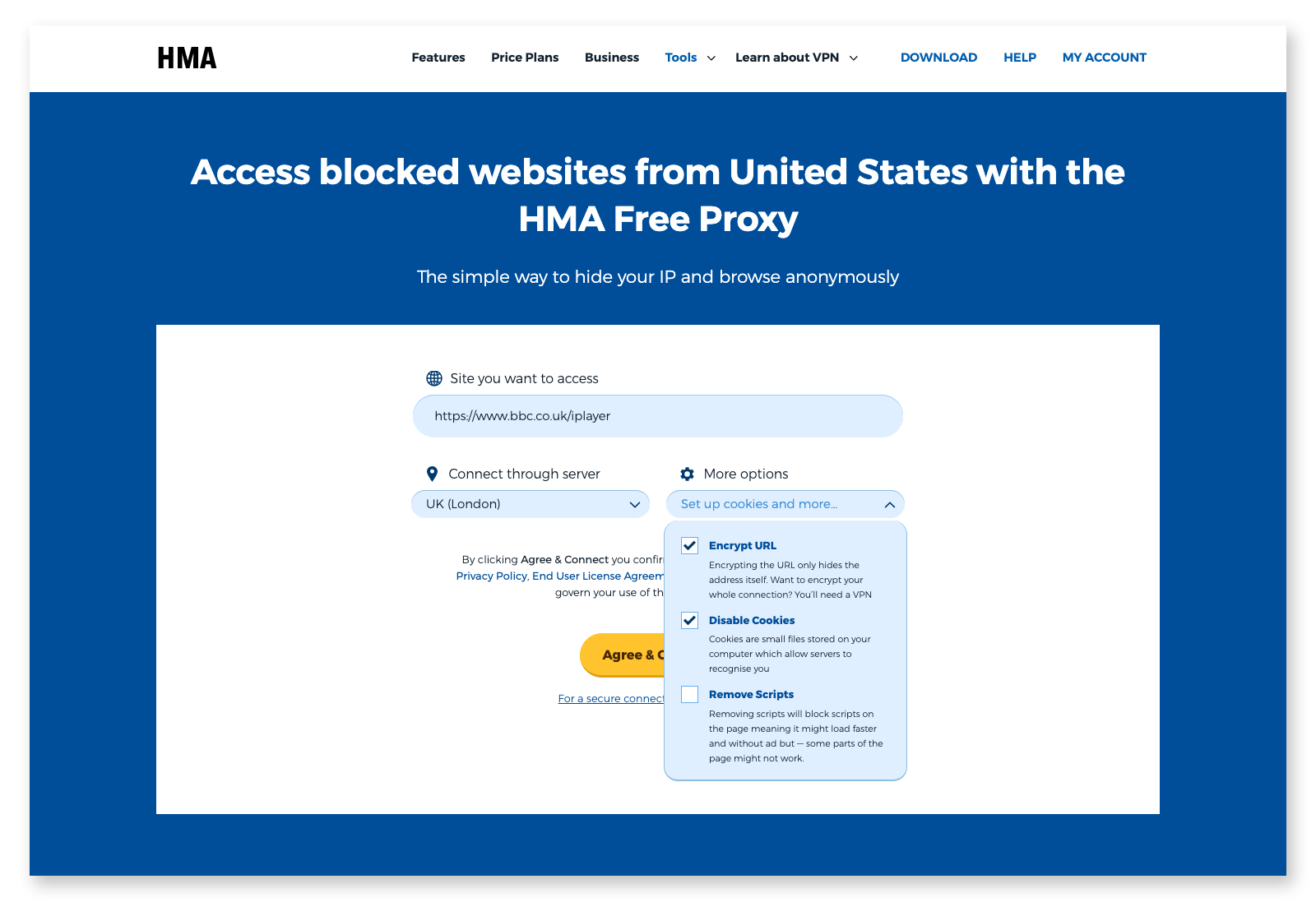
HMA will display a toolbar at the top of the page.

This lets you choose a location to appear from when you visit a site, which removes content blocks.

For more more information, check out our guide to setting up a proxy.
Google keeps local copies of websites to help them load more quickly when you visit them. This technique is called caching.
If you're blocked from the original version of a site, you may still be able to reach its cached version. Here’s how to find the cached version of a website or page in Chrome:
Go to Google’s homepage and enter the website or webpage of the site you want to unblock.
Click the down arrow to the right of the site’s URL (or the three vertical dots).

Click Cached — if you’re lucky, it’ll open.
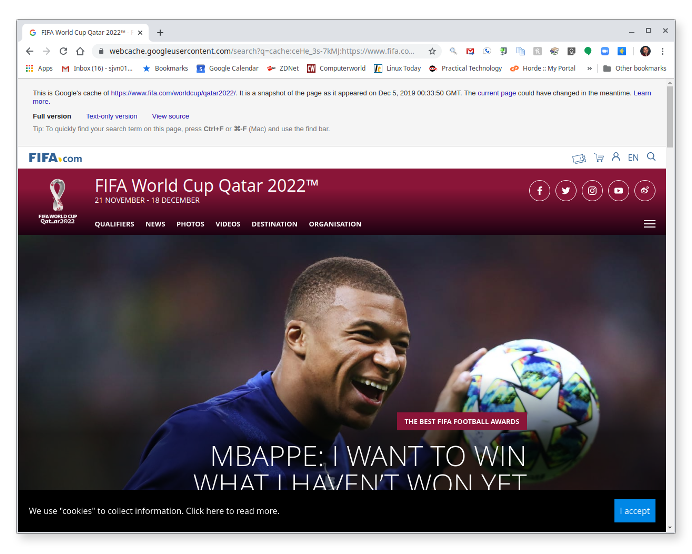
You may be able to bypass unsophisticated website-blockers by using a URL shortener service such as Bitly, TinyURL, or ls.gd. These services replace a website's URL address with a shorter domain name. If your school or business blocks YouTube, the Bitly shortened version might unblock the video for you.
To use Bitly as a website unblocker, take the following steps:
Search Google for the page you want to find. Then copy the page's URL.
Go to the Bitly website and paste the URL into the “Shorten your link” field.
Copy the resulting shortened URL.
Paste the shortened URL into your web browser's address bar and you may be taken to the page you want.

Some crude site-blocking software targets only domain names — not the site’s IP address. Find your site's IP address using the Whois lookup tool. There, you'll find a lot of information about a site, such as who owns it, and what its IP address is. Then, armed with this information, you may be able to get to the website.
For example, instead of accessing Facebook with its domain name — facebook[dot]com — you may be able to open the website by using Facebook’s IP address: 31.13.71.36. To try this, type in //31.13.71.36 into your browser’s URL field — that might work, depending on the type of website-blocking software that’s being used.

Some of the most convenient website unblockers are available as browser extensions, letting you automatically bypass web restrictions. There are a wide range of browser extension proxies optimized for all the most popular browsers. These extensions have the same functionality as a proxy website, but they’re plugged directly into your browser so you don’t have to visit an actual proxy website to unblock the content.
Here’s how to get a website unblocker browser extension on your Chrome browser:
Open up Chrome, click the three dots icon in the top-right corner, and then click More tools followed by Extensions.

Open the Extensions menu by clicking the hamburger icon in the top left, and then click Open Chrome Web Store at the bottom of the menu.

Enter proxy or proxy server or proxy server VPN into the Chrome web store’s search field. Find the extension you want to add, select it, and then click Add to Chrome to download the extension.
When the confirmation pop-up appears, click Add extension to confirm installation.
Then click the extension’s icon (you should now see it in the top right of your Chrome browser, next to the URL field) and begin using it.
If you use a Mac device, you can also set up a proxy directly within your Safari browser, so you won’t need to manually connect via a proxy service each time you want to unblock a site.
Here’s how configure your proxy settings in Safari:
Launch your Safari browser and open up Preferences via the Safari menu.
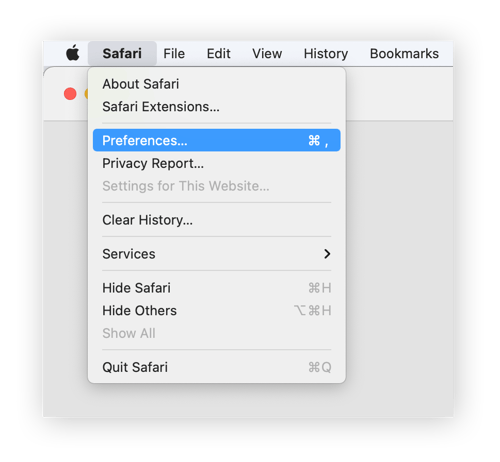
Click the Advanced tab and then the Change Settings button next to Proxies.
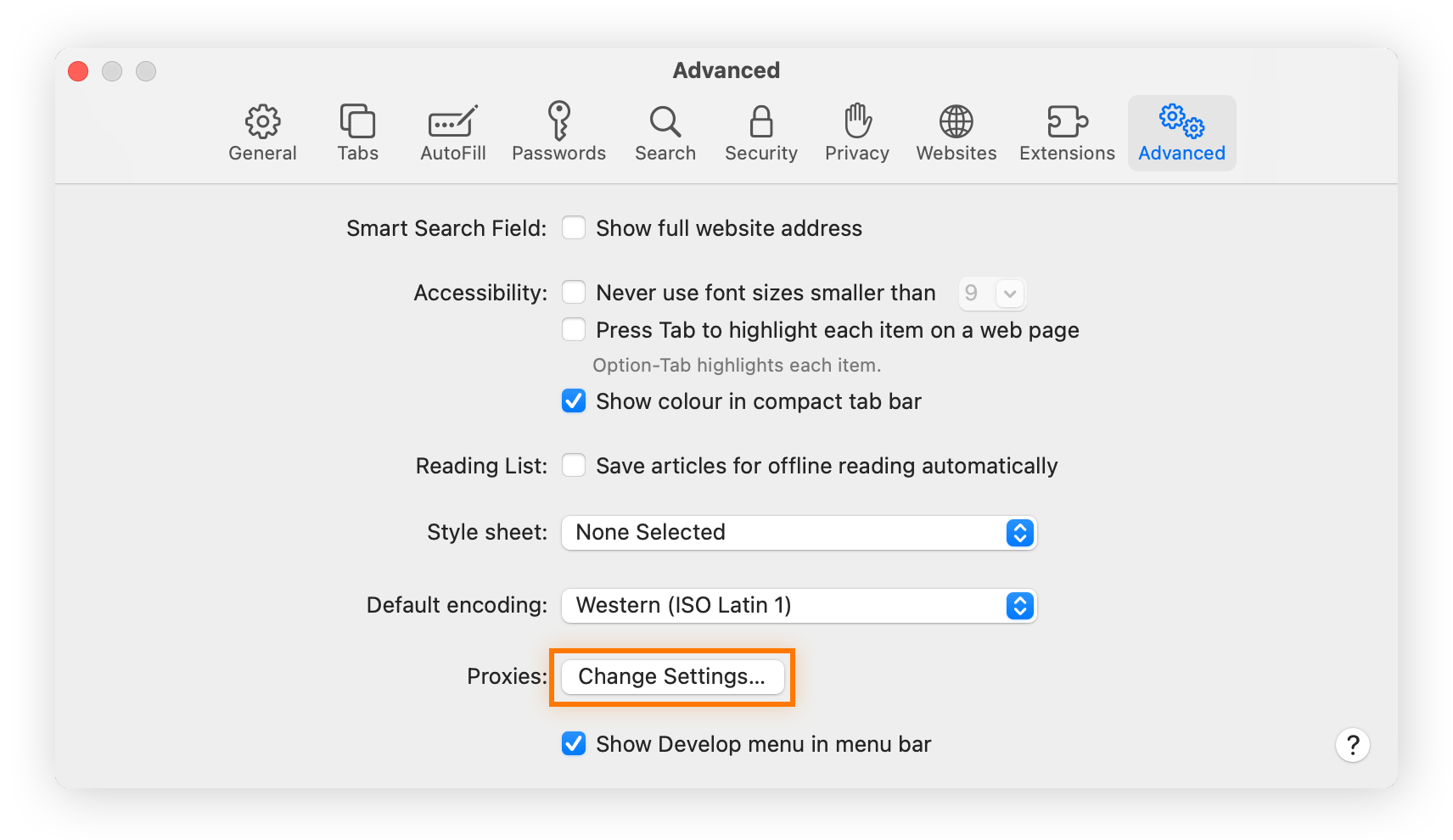
Under Select a protocol to configure, ensure that the proxy you want to edit is selected.

Add the endpoint address for your preferred proxy service in the Secure Web Proxy Server field.
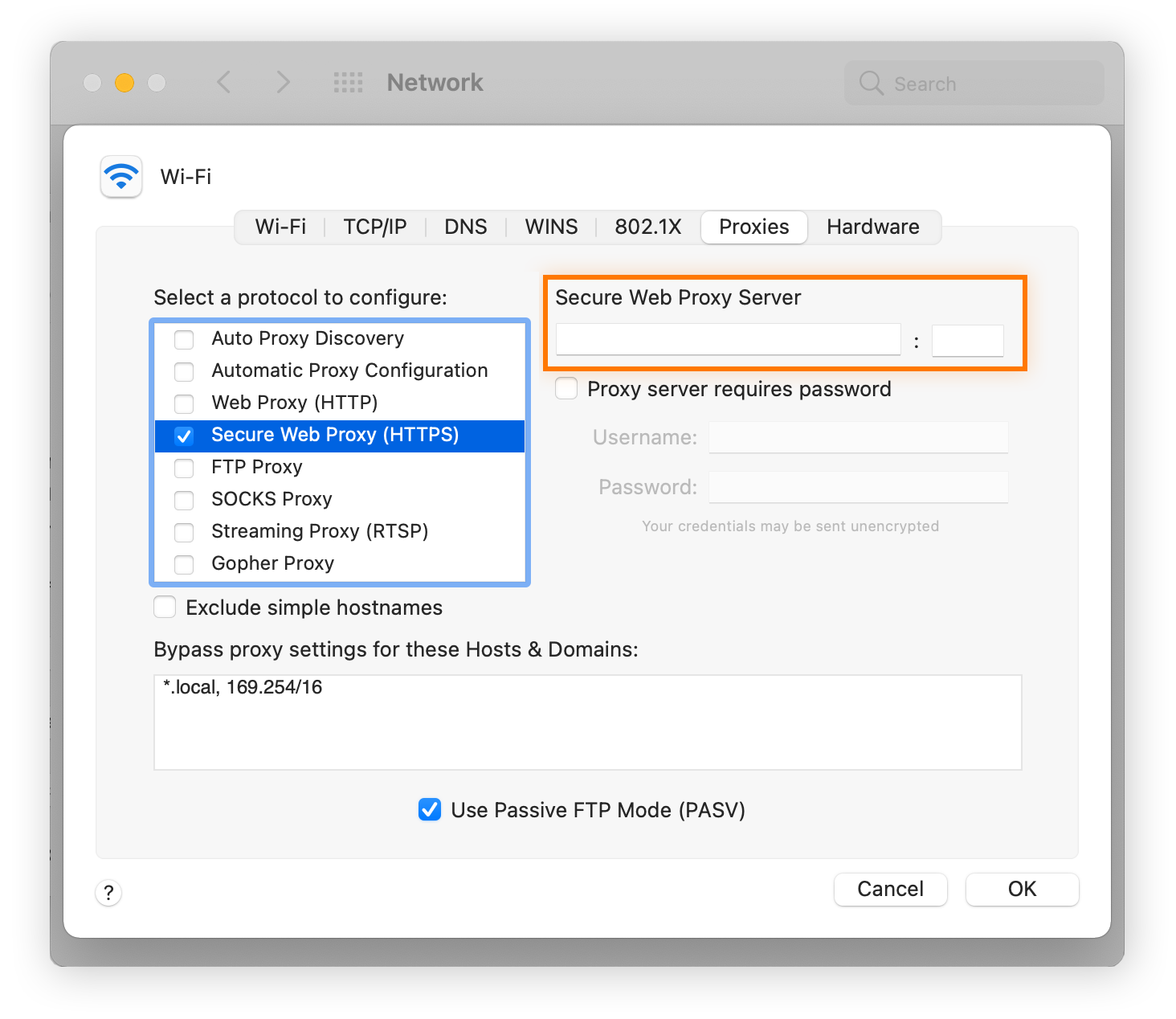
Click OK, then Apply to complete the setup.
Most sites now offer both secure (HTTPS) and unsecured (HTTP) access. You can sometimes trick a school or work firewall into unblocking a site by using the HTTP version of an address. So if https://www.example[dot]com is blocked, you may be able to get to it by using its unsecured address (http://www.example[dot]com) or vice-versa. However, HTTP is an unsecured protocol, and we don’t recommend using it if you can avoid it — especially if you plan to enter any personal details into the website.
Tor (The Onion Router) is an open-source project comprising Tor Browser, based on the Firefox browser, and the Tor network. Tor Browser places multiple layers of encryption on your traffic, which is then randomly directed through the Tor network to hide your IP address before reaching the blocked website you want to access. This multilayered protection system is where Tor gets its name, and you can anonymously unblock access to most websites with it, including dark web sites.
While you can get to almost any site using Tor, your web browsing will be slow. That's because the Tor network is maintained by volunteers and performance isn’t the top priority — anonymity and privacy are.
If you’re on a school or company network, you might be blocked from downloading Tor. But give it a try and see if you can. Here’s how to use Tor:
Go to the Tor Browser site.
Select the device you’re using and follow the instructions to install Tor.
When Tor first launches, it will give you some configuration options, depending on what country you’re in and what your internet network settings are.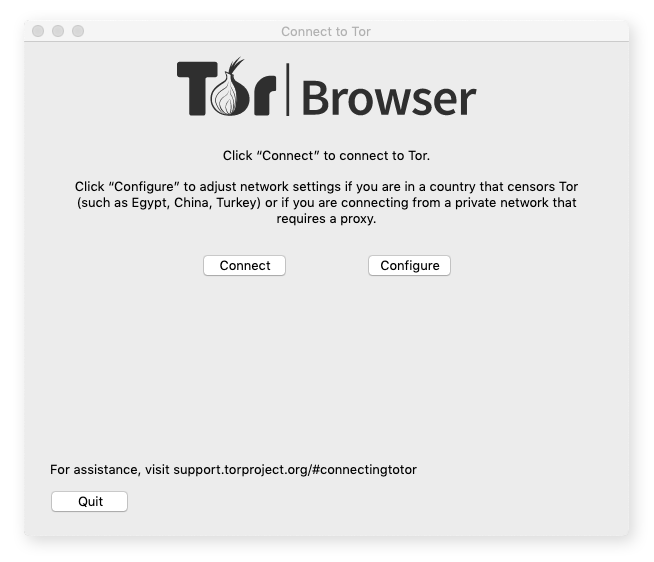
Once you’ve configured Tor (if necessary), go ahead and connect.

Now you’re in the Tor Browser, and you should be able to access whatever blocked website you were trying to reach.
Which is best for you: VPN, proxy, or Tor? It depends on what type of network you’re on and what content you’re trying to access.
The best, most secure way to unblock forbidden websites is to use a VPN, a virtual private network that secures and encrypts your data. When using a VPN, you connect to a remote VPN server, and it then connects you to a website, hiding your real IP address and allowing you to bypass many restrictions on the sites you visit.
Avast SecureLine VPN works on Macs, Windows PCs, Android, and iOS devices. Below, we show you how to use Avast SecureLine VPN, but the process of setting up a VPN is similar no matter what VPN you choose.
Download Avast SecureLine VPN:
Click the install file to install it and launch the application.
Click on Change Location to see all the VPN server locations you can choose to appear from, and select one where your desired content will be available.
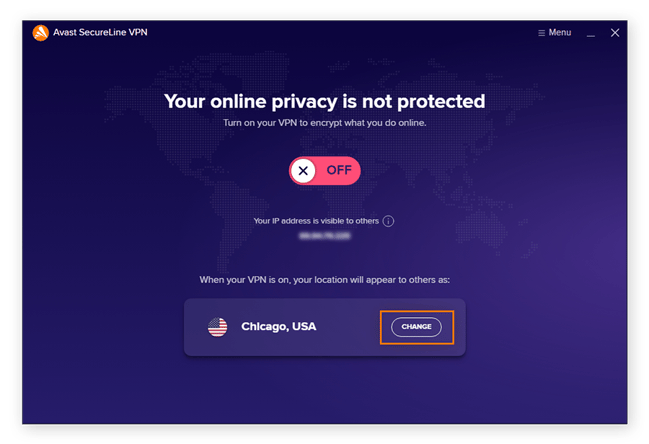 When you first launch a VPN, it will show you hat your privacy is not yet protected.
When you first launch a VPN, it will show you hat your privacy is not yet protected.
If you want to stream content, select Streaming on the bottom-left to see the server locations that offer the most reliable streaming. Choose a server location from which your blocked content will be accessible, such as a VPN server in the United States or a UK VPN server.

Connect to the server and enjoy the blocked content you want.
 You can now stream content from your preferred location. Plus, your connection is encrypted for online privacy.
You can now stream content from your preferred location. Plus, your connection is encrypted for online privacy.
The specifics of how to set up a VPN may vary depending on your operating system or device. And as with other technology, there are ways to try to speed up your VPN if you notice performance lagging.
It’s easy to unblock websites with a free trial VPN on your personal computer or mobile device, but it may not be the best option when you’re on a public computer at school or in a library.
Using a web browser designed specifically with privacy at the forefront helps prevent web tracking and masks your digital identity. Although not primarily used as web unblockers, private browsers provide an extra layer of online anonymity and security, and form a potent partnership with any of the methods outlined above.
More important, the best private browsers — such as Avast Secure Browser — have built-in features like VPNs that help you hide your IP address and encrypt your connection without compromising your browsing experience.
All the above methods can help you get to the sites you want, but some work better than others depending on if you’re at school, work, or abroad. Let's go into more detail on what works best in different situations.
You probably can’t install a VPN on a school computer, making it a bit trickier to unblock websites at school. Nor should you install the Tor browser on a school computer. Schools often discourage (or even ban) Tor's use, because it can be used to access the dark web.
The best way to unblock sites at school is to use a proxy or browser extension, as described above. The quick methods above, like using a URL shortener, may work as well.
When you’re using not just a third-party network, but also third-party hardware such as a school Chromebook, unblocking websites is more challenging. Without admin rights to your school Chromebook, you won’t be able to install tools like VPNs or Tor to bypass content restrictions.
Your best bet is to try using a web proxy service to conceal your internet traffic without having to download any software. But network admins may already have blocked many of the more popular proxy sites, so you may need to hunt around. If you’re unable to access any proxy services, try using a URL shortener or the Google cache method.
If you're using your own PC for work or have administrative rights on your work computer, a VPN is your best answer to unblock websites at work. But if you don't have the authority to install software on your PC, or you're hot-desking, a VPN may not work.
Many companies use their own proxy servers as content filters to prevent employees from accessing certain websites and apps. You can try to circumvent your company’s proxy with a public web proxy — if your company hasn’t blocked these as well. If you can connect to a public web proxy, it should allow you to access the websites you want.
Your company almost certainly would prefer that employees refrain from installing Tor Browser on company equipment, so avoid using it.
If there’s a website you really want to access and you can’t get around company restrictions, you may need to use your own device.
If you’re traveling or you want to access a website that blocks access by geolocation, the best way to unblock the website is likely with a VPN. If you're dealing with particularly aggressive restrictions, try using Tor.
Some countries, such as China with its Great Firewall, make it especially difficult to access the open internet. While some VPNs work, they often have trouble. In addition, some VPNs are completely blocked, and Tor won't work at all in China.
Most of the options listed above should work equally well on a mobile device. But with phones, VPNs are the best and easiest option — there are plenty of Android VPN and iPhone VPN apps to choose from.
Fiddling with slow web proxies on jumpy networks can be a nightmare. Public proxies don't lend themselves to unblocking websites over the phone. That's because every time you move your phone, it has to reconnect with the proxy. In addition, a poor connection can make the already slow public proxies unbearably slow.
If you have an Android phone, you can try Tor. You can also try a third-party browser like Onion, which uses the Tor network but isn’t as secure as Tor.
Schools and businesses may block some websites for productivity reasons or to make sure users on their networks don’t access unsafe content. Governments may block websites because of censorship — they want to control access to information.
Businesses, schools, governments, and content providers block sites by checking to see if your IP address has the right permissions. So when you find your access blocked, one way to get around the restrictions is to hide your IP address using either a VPN, a Proxy, or Tor.
Here are some of the most common reasons why websites are blocked.
Both schools and businesses block some websites for productivity reasons. For example, many schools ban porn, gaming, and gambling sites. And your employer wants you concentrating on work, not sharing cat videos on Facebook.
Another reason schools and businesses block websites is that they don't want their bandwidth used for sites and services that consume a lot of data. That's why most block you from watching videos or streaming sporting events. Whether it's a YouTube video or a live football match, both consume lots of bandwidth, which the provider would rather use for official purposes.
Entertainment services like Netflix have different content available from one country to the next. This kind of geo-blocking is usually done because of content licensing agreements. For example, you can watch Star Trek Discovery on Netflix in Europe, but not in the United States. That's because CBS All Access has the rights to stream in the US, while Netflix has the show’s international rights.
Some countries, such as China, Russia, Iraq, and North Korea censor a wide variety of content for political reasons. China has famously blocked many global social media platforms — you can't use Twitter, Facebook, Instagram, or even WhatsApp in mainland China without a VPN.
Using tools such as proxies and VPNs to unblock websites is generally legal, but rules vary from country to country. Most countries, even China, allow some use of VPNs. In the west, VPNs tend to be completely legal. But whenever you try to get around content blocks, keep in mind the following:
Streaming, sharing, or viewing illegal content — for example, torrenting copyrighted materials — is almost always illegal.
While it's not illegal to use streaming services such as Netflix over a VPN, it may breach their terms of use. These services have been known to ban users.
Most VPNs promise not to log your use of their service, but some VPN providers have shared user information with law-enforcement agencies.
The freedom and security that come with using a VPN to unblock sites far outweigh the hassle of downloading the software. While some of the other methods to unblock sites may be quicker, nothing can beat the security of a VPN. Whether you simply want to unblock a website, access content while traveling abroad, or protect your online privacy, a VPN is your best choice.
Avast SecureLine VPN has got everything you need to unblock websites quickly, safely, and reliably. With tons of server locations across the world, no bandwidth limits, ultra-secure AES-256 encryption, and a kill switch, Avast SecureLine VPN lets you anonymously access all your favorite sites and services anytime, anywhere.
If it’s not possible to set up a VPN — for example on a computer for which you don’t have admin rights — you can still unblock websites using web proxies, the Google cache, URL shorteners, and other methods. But the encryption VPNs offer provide stronger security and more flexibility.
Proxies and VPNs are completely legal in most countries, and using them to unblock websites is generally permitted. But getting around content blocks to stream or share illegal content is almost always against the law. While it's not illegal to watch TV online or use streaming services such as Netflix with a VPN, it may breach their terms of use, and these services have been known to ban users for bypassing geoblocking restrictions.
If you’re having trouble accessing a site on Google Chrome, you may be able to unblock it without a VPN. It’s possible the website is on Chrome’s Restricted sites list, and it’s being blocked by the browser itself. But if removing site restrictions doesn’t work, your best bet is to switch to the Tor Browser or use a proxy server via a Chrome privacy extension or web proxy site.
The features that make Tor one of the best browsers for privacy are also great for unblocking websites. But some secure browsers, such as Avast Secure Browser, come with integrated VPNs that can get around content blocks — and they also offer additional layers of privacy and security, such as phishing protection and web tracking prevention.
A VPN is the best tool to use to safely and reliably unblock websites. Premium VPN services like Avast SecureLine VPN don’t just bypass web-blockers; they also let you choose your server location for an optimal connection, hide your IP address, and encrypt your internet traffic. Plus, VPNs are easy to set up on mobile devices too.
Download Avast SecureLine VPN to get around website blocks, access content wherever you are, and stay private online.
Download Avast SecureLine VPN to get around website blocks, access content wherever you are, and stay private online.
Install Avast SecureLine VPN to get around website blocks, access content wherever you are, and stay private online.
Install Avast SecureLine VPN to get around website blocks, access content wherever you are, and stay private online.
Unblock content and stream freely with Avast SecureLine VPN
Unblock content and stream freely with Avast SecureLine VPN